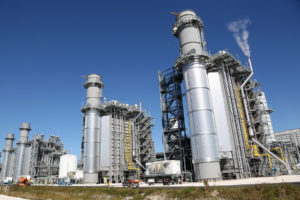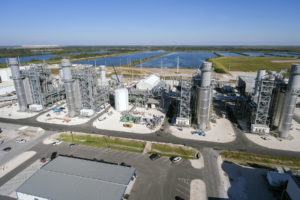
For providing 20 years of safe, reliable electricity to growing West Central Florida, what do you get the power station that has everything? (And by “everything,” we mean worldwide renown, bold innovation, the highest honor in the electric utility industry and team members and contractors that care about the community.)
Simple – you get it the same thing our customers get:
More power.
More power to you is the story behind the 460-megawatt (MW) upgrade at Tampa Electric’s Polk Power Station. After the infusion of power the company received when it joined Emera, Inc. last year, the new Polk Unit 2 produces enough electricity for more than 100,000 homes – power generated with a focus on efficiency as well as Tampa Electric’s responsibility to the environment.
Polk 2 is the result of a project that broke ground in 2014 to meet the power needs of a growing community. It combines four natural gas-fired simple-cycle units into a single unit, called combined-cycle, that uses the waste heat of the existing combustion turbines to produce additional power. This increases the output of the gas-fired units by 70 percent.
“It was a tremendous challenge to bring a project like this from the drawing board to reality,” said Kris Stryker, senior project manager with the Polk 2 project. “It was only possible because of the dedication and talent of a great team that all worked together to achieve a common goal. After working on something for over five years, it was extremely satisfying to see the new plant run smoothly and on schedule.”

Of course, that power needs to get to customers, which is where the complementary project to build about 40 miles of transmission infrastructure – safely and with environmental sensitivity – came into play. This effort came with plenty of its own challenges, said Paul Allen, manager of Project Management with TECO’s Energy Delivery team.
“The amount of transmission and substation construction along with the tight schedule was very challenging,” he said. “It could not have been completed on time without the dedicated work of the project team that included contractors and team members from all over the company. Watching the individual sections of the project enter service over the last three years, leading up to the final one last December, was very rewarding.”
And all of this is happening at the same time you’re paying less for power from Tampa Electric.
“The Polk 2 project has been a long road that brought us to this moment, and it’s been an incredible journey,” said Karen Sheffield, director of Polk Power Station. “As transformative as Polk Power Station was when it got its start in 1996, it continues to improve and demonstrate value to the community. Beyond power generated with environmental responsibility, for example, it’s been a generator of jobs in this area for TECO team members and contractors.”
And that’s not all…
More safe, reliable, affordable power isn’t the only great recent news coming out of Polk Power Station. Reclaimed water from Lakeland, Mulberry and Polk County now goes to the station to help cool the generators. This addresses a critical need for water for the Polk 2 project by diverting previously discharged wastewater and treating it for beneficial reuse at the power station.

The Polk Power Station Regional Reclaimed Water Projects project earned Polk Power Station the Edison Award, the electric industry’s highest honor, in 2015.
“The effort to build Polk 2 and the transmission infrastructure to accompany it has been tremendous,” Sheffield said. “I couldn’t be more proud of the engineering and construction teams who completed this project and the teams at the plant who carry forward the day-to-day operations of the power station. Both deserve huge thanks for their unwavering dedication.”
From a refurbished playground in Mulberry to homes, businesses and other customers across the area – from us to you – Polk Power Station is more than just a symbol of our commitment to everyone we serve. It’s an investment in the present and future to help keep the community humming.
Some more facts about Polk Power Station
- Polk 1 is a nominal 250 net MW, Integrated Gasification Combined Cycle (IGCC) base loaded facility – one of only three in the United States.
- It was partially funded by the Department of Energy’s Clean Coal Technology Program.
- It was one of the first power plants to use a local community siting task force, made up of local academics and environmentalists, to recommend a geographical site for the plant. They settled on using reclaimed phosphate mining land as the eventual home for Polk 1.
- Polk Power Station started its life using 100 percent coal but moved to a 15 percent coal/85 percent petcoke blend. This fuel diversity takes advantage of a refinery byproduct to generate lower-cost megawatts. The station is currently configured to use natural gas by co-firing, which increases availability and fuel flexibility.
- In 1997 Power Magazine declared it “Plant of the Year” for its innovative design, construction and technology.
- In 2005 Polk Power was declared the “Cleanest Coal fired Power Plant in North America” by Energy Probe, a Canadian consumer and environmental public interest group.
- Polk has produced more “clean” megawatt-hours than any other IGCC plant in the world. The IGCC technology produces megawatts with lower particulate and sulfur dioxide emissions compared to conventional coal plants.
- Polk 1 is also a zero-liquid-discharge (ZLD) facility, which means lower water use.

No Comments Found